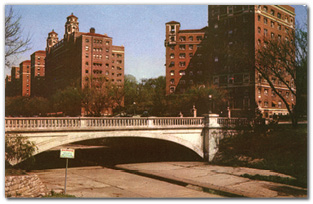
By MICHAEL BUSHNELL
Northeast News
September 17, 2014
This Kodachrome postcard published in the late 1950s shows the numerous apartment buildings built on the south side of Brush Creek near the Country Club Plaza. The bridge shown in the card was deemed obsolete following the tragic flood of 1977, which killed 25 people and caused over $100 million in damages to businesses along the banks of the normally placid creek.
A new bridge was erected in 1980-81 that allowed for a more freely flowing Brush Creek during high water periods. Easily visible in the foreground of the card is the concrete-lined bed of Brush Creek. When J.C. Nichols first developed the Plaza as the premier shopping district in Kansas City, Brush Creek was nothing more than a trickle lined with brambles and small trees.
Soon after the Plaza’s heralded opening, political “boss” Tom Pendergast provided his “solution” to the flooding in the creek’s watershed area by lining the creek with his Ready-Mix concrete from roughly State Line to Troost Avenue. This poorly thought-out solution, however, did nothing more than create a swifter moving current through the Plaza after periods of heavy rain.
This came to a head 30 years ago today, when heavy rain clouds literally parked over the Kansas City area, saturating the ground with more than 12 inches of rain in some areas in a 48-hour period. The resulting disaster prompted city fathers to aggressively seek a more permanent solution to Brush Creek’s constant threat of flooding. The new Brush Creek flood control plan was completed after the flood of 1998. The apartments pictured in the background were among the first to be erected overlooking the Plaza business district.
From right to left are the Villa Serena (now the Hotel Raphael), the Locarno, the Riviera (now the Hemingway Plaza East condominiums), the Biarritz, and the Casa Loma. All were built in the mid- to late-1920s.

















